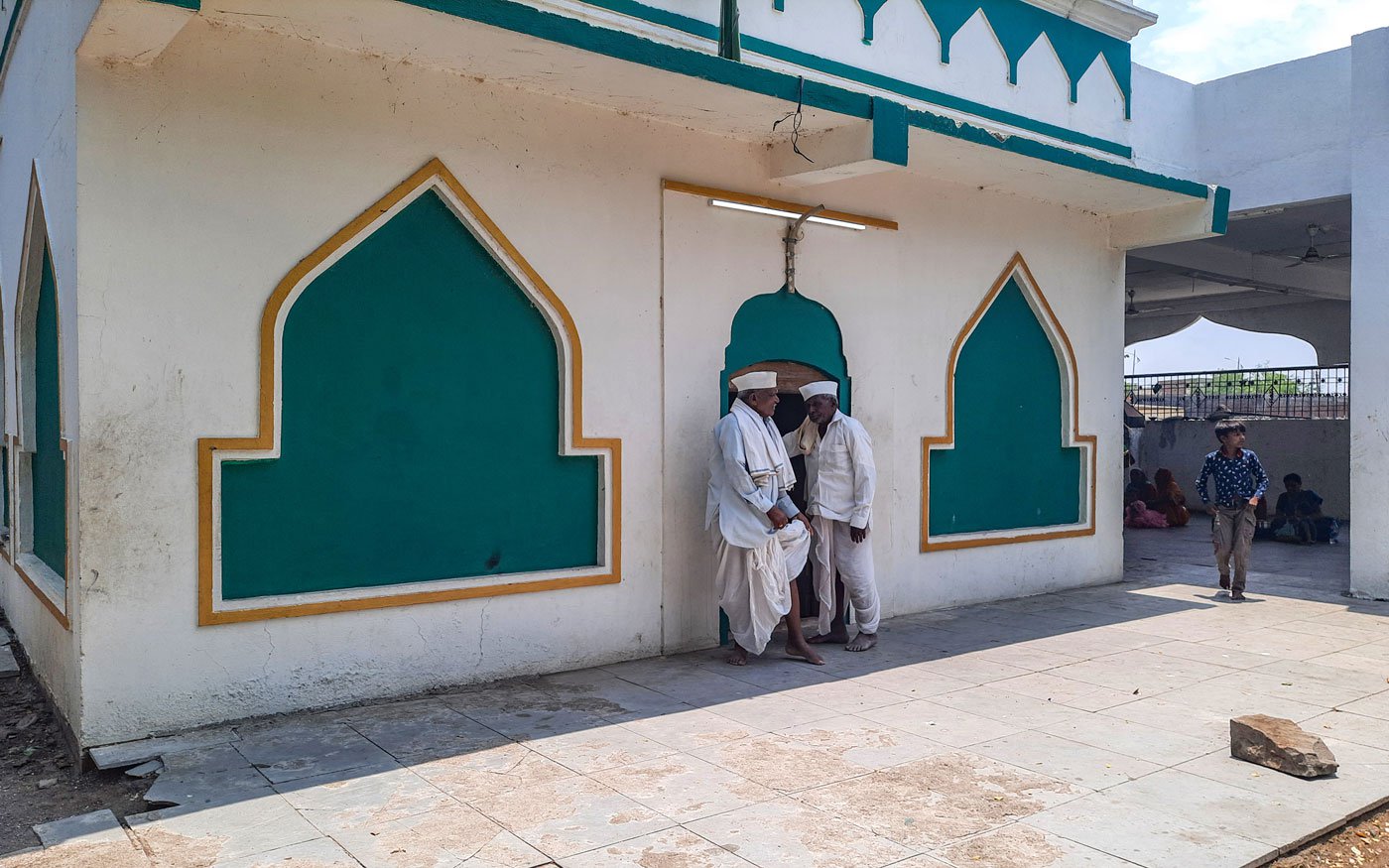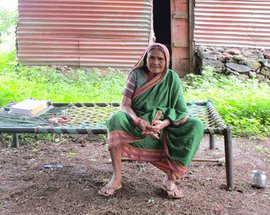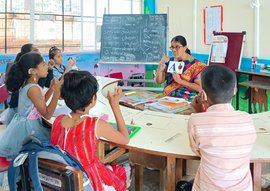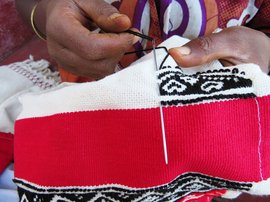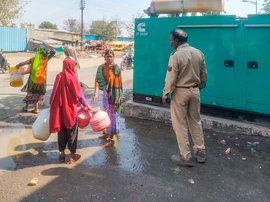It’s a hot and humid afternoon in May, but the Hazrat Sayyed Alwi (Rehmatullah Alaih) dargah (shrine) at Moha is teeming with people. Forty families, more Hindus than Muslims, are busy with their annual worship and feast called kanduri . The Dhobale family is one of them, and my family and I are their guests at this 200-year-old dargah in Kalamb block of Osmanabad district.
In the summer months when farming families have some free time, dargahs of peers (holy men) in Osmanabad, Latur and six other districts – Beed, Jalna, Aurangabad, Parbhani, Nanded and Hingoli - in the Marathwada region, are usually bustling with activity. On Thursdays and Sundays, families arrive in large numbers. They sacrifice a male goat, offer a nivad of the cooked meat, seek blessings, eat together and feed others.
“We have done this [ kanduri ] for many generations,” says Bhagirathi Kadam, 60, our relative from Yedshi (also spelt as Yedsi) in Osmanabad. The region of Marathwada had Muslim rulers since the 13th century, (including the 224-year rule of the Nizam of Hyderabad). Belief and worship at these Islamic shrines are ingrained in people’s faith and rituals – representing a syncretic way of life.
“We worship at Gad Deodari. Those from Tawaraj Kheda come here to Moha and people from your village [Borgaon Bk. in Latur district] have to visit Shera,” Bhagirathi, fondly known as Bhaga mavshi says, outlining the centuries-old custom of villages being assigned specific dargahs for worship.
Here at the Hazrat Sayyed dargah in Moha, under every tree and shelter of tin roofs or tarpaulin sheets, people have set up chulhas (makeshift stoves) and food is being cooked to be offered during the rituals at the dargah . Men and women are chatting while children play to their heart’s content. The air is hot but clouds gathering on the western skies bring in some shade as does the canopy of old tamarind trees that line the entrance and provides a respite from the heat. The water body in the dargah – a 90-feet deep, old stone well called baarav is dry but a devotee informs us it will, “fill with water during monsoons.”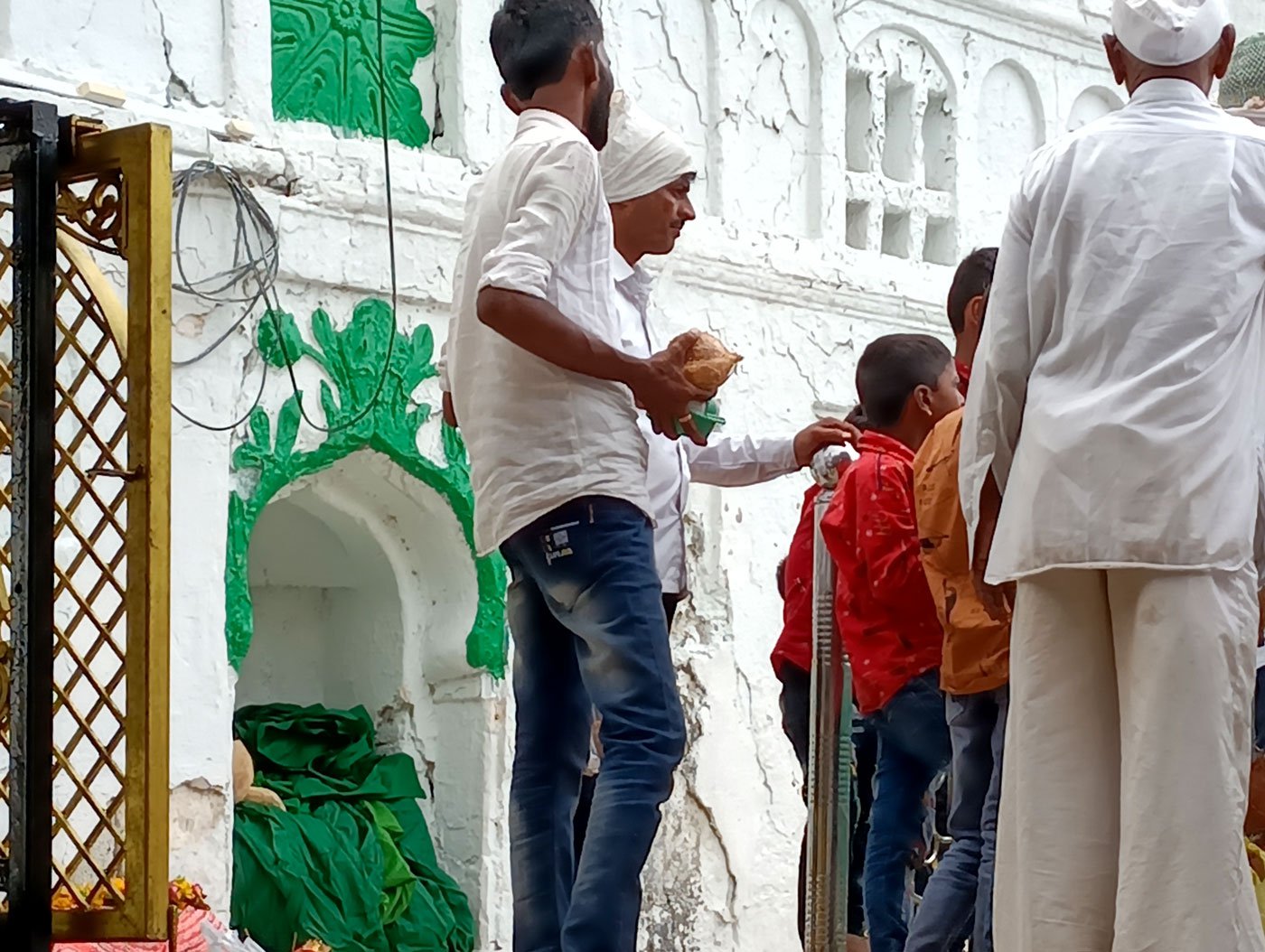
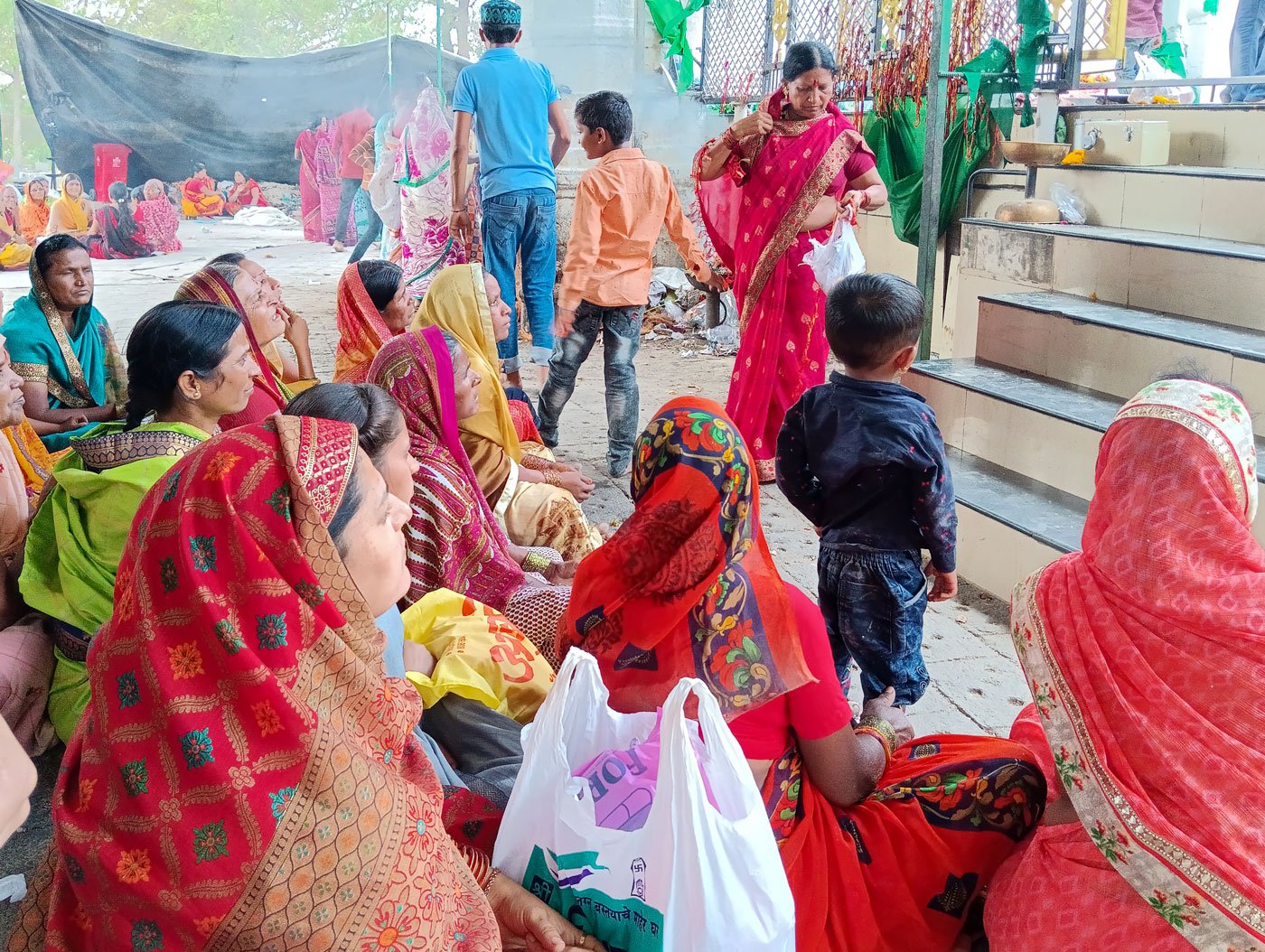
Left: Men offer nivad and perform the rituals at the mazar at Hazrat Sayyed Alwi (Rehmatullah Alaih) dargah (shrine) at Moha. Right: Women sit outside the mazar, near the steps to watch and seek blessings; their heads covered with the end of their sarees as they would in any temple
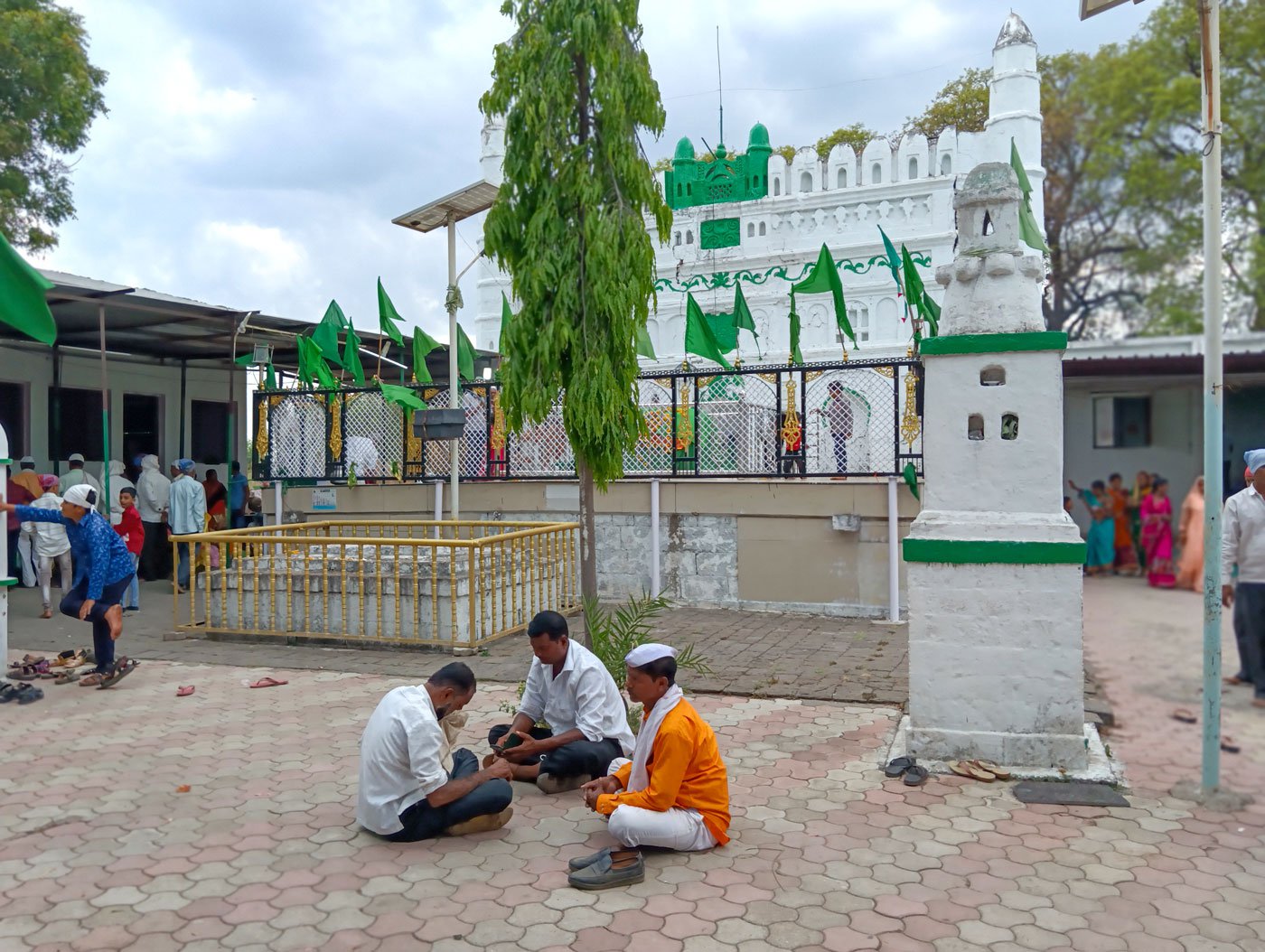
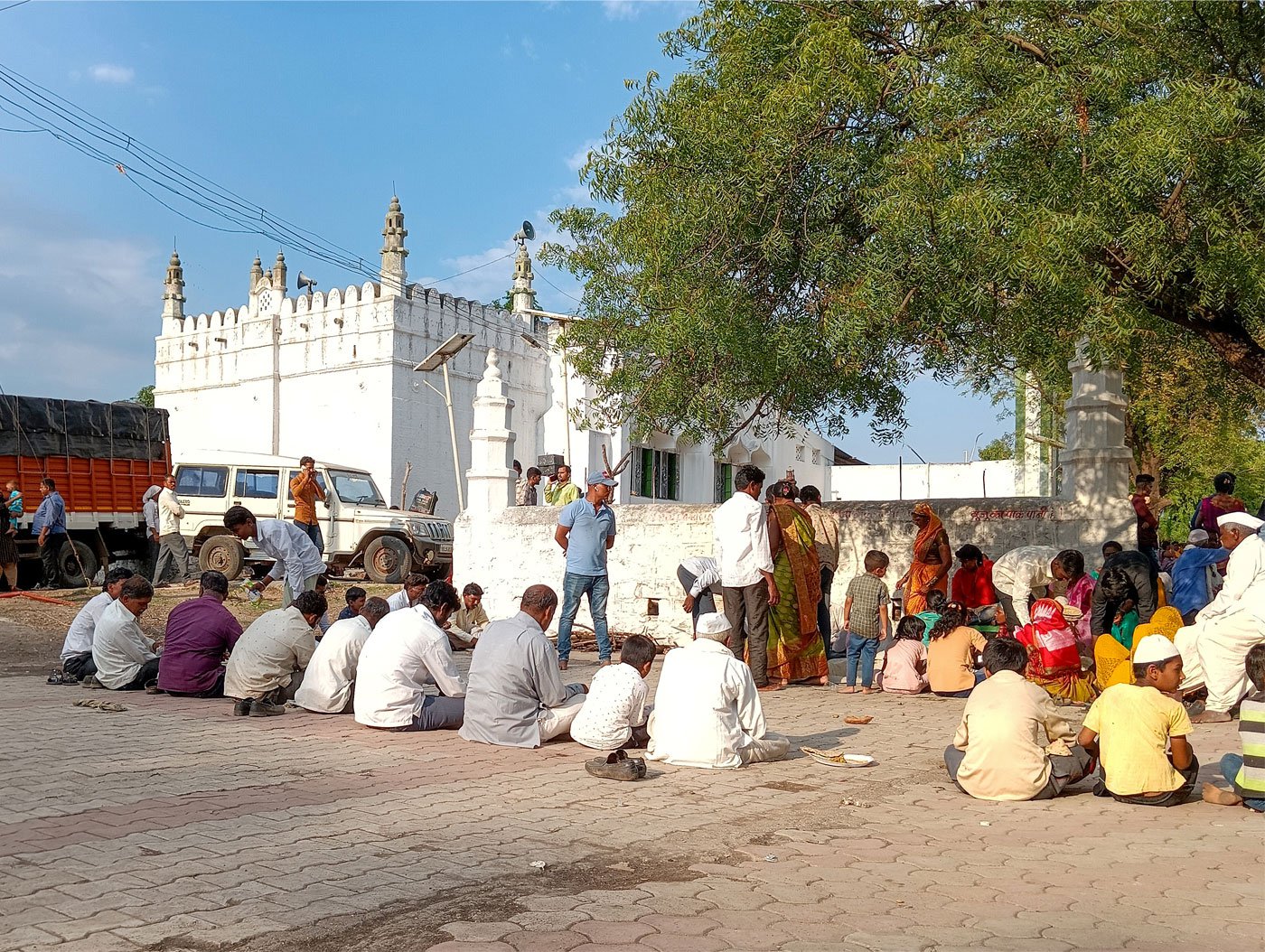
Left: People sit and catch up with each other while the food is cooking. Right: People eating at a kanduri feast organised at the dargah in Moha, Osmanabad district
A man in his late sixties enters the dargah carrying his aged mother on his back. In her late eighties, the lady is wearing a faded nine-yard light green irkal saree, worn by both Hindu and Muslim women in this region. As her son climbs the five steps of the mazar (saint’s tomb), his mother’s eyes turn moist, and she joins her hands and humbly prays.
Other devotees follow – a visibly sick and disturbed woman in her forties enters with her mother. The mazar is located almost 500 metres from the main entrance and both take very slow steps to reach here. They offer coconut and some flowers and light incense at the mazar . The mujawar (caretaker) gives back the open coconut and a thread to tie on the wrist of the sick woman. The mother puts a pinch of the ash of the burned incense on her daughter’s forehead. Both sit under a tamarind tree for some time and then leave.
A metal fence behind the mazar is crowded with glass bangles in shades of neon and light green. Women of all faiths, place these hoping for a suitable match for their daughters. In a corner on one side, a large wooden horse is stationed with a few clay horse figurines in front. “These are offered in the memory of the revered Muslim saints who rode horses in their lifetime,” Bhaga mavshi fills me in with details.
I recall the two horses worshipped daily at my mother-in-law’s home. They suddenly mean something. One belongs to Bhairoba, a Hindu deity and one to the peer , a revered Muslim fakir (mendicant).
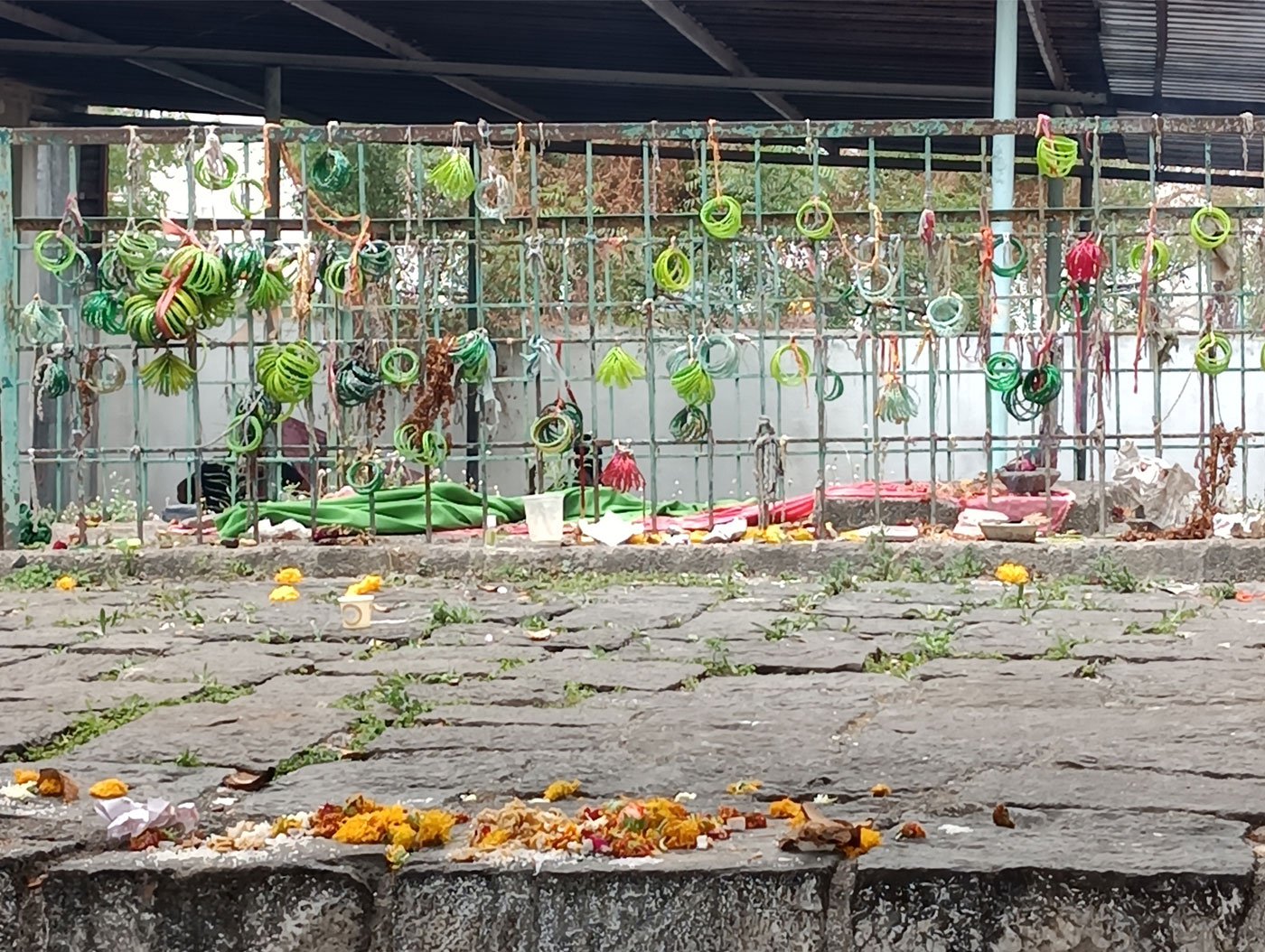
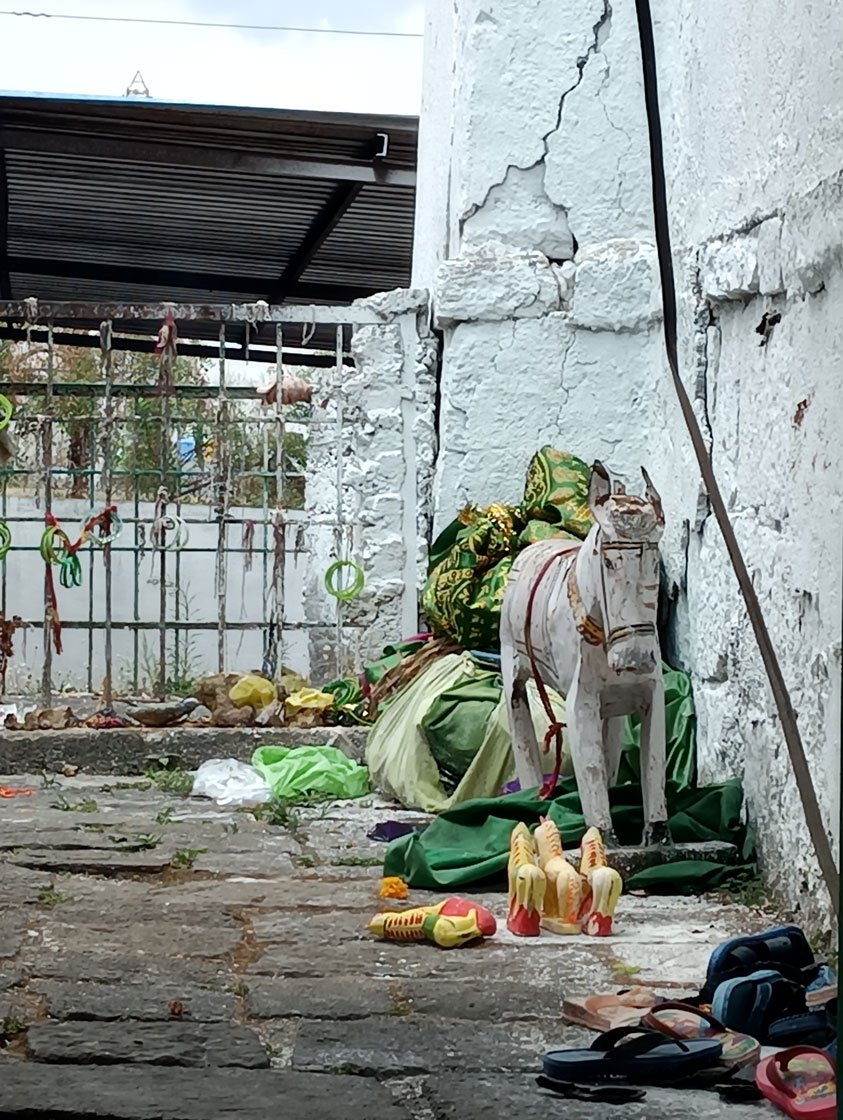
Left: Women who are seeking a match for their daughters tie bunches of light green or neon bangles to a metal fence behind the mazar. Right: A large wooden horse with a few clay horse figurines are offered by people in memory of revered saints who rode faithful horses
*****
Many women have been up since midnight preparing for the annual kanduri feast which includes meat curry and bhakri . But some of them won’t be eating the mutton because Thursdays are no-meat days in their calendar. “Eating is not so important,” one of the ladies tells me. “ He devacha kaam ahe, maay [We do it for the god, my dear].”
Women’s labour is the backbone of such feasts. Many won’t partake of the food but say they are happy eating upvaas food cooked for a few vegetarians and those who are fasting. The fact that meat will be cooked on the same chulha , eaten in the same plates, does not disturb them: No hurt feelings; no outraged sentiments.
Lakshmi Kadam lives in Pune and has come for the feast and is tired now, making hundreds of bhakri , grinding masalas for the curry, washing and cleaning throughout. “I envy ‘their’ [Muslim] women,” she says tiredly. “One big pot of biryani and they are done! Ha asla rada nako na kahi nako [They do not have to do as much of the work as we have to].”
“See their cheeks, nice and pink!” Her envy now leads to ideas and imagination. Most of the women around us are thin and overworked, barring a few from well-off, upper caste families, not quite the “pink cheeked” women Lakshmi imagines them to be.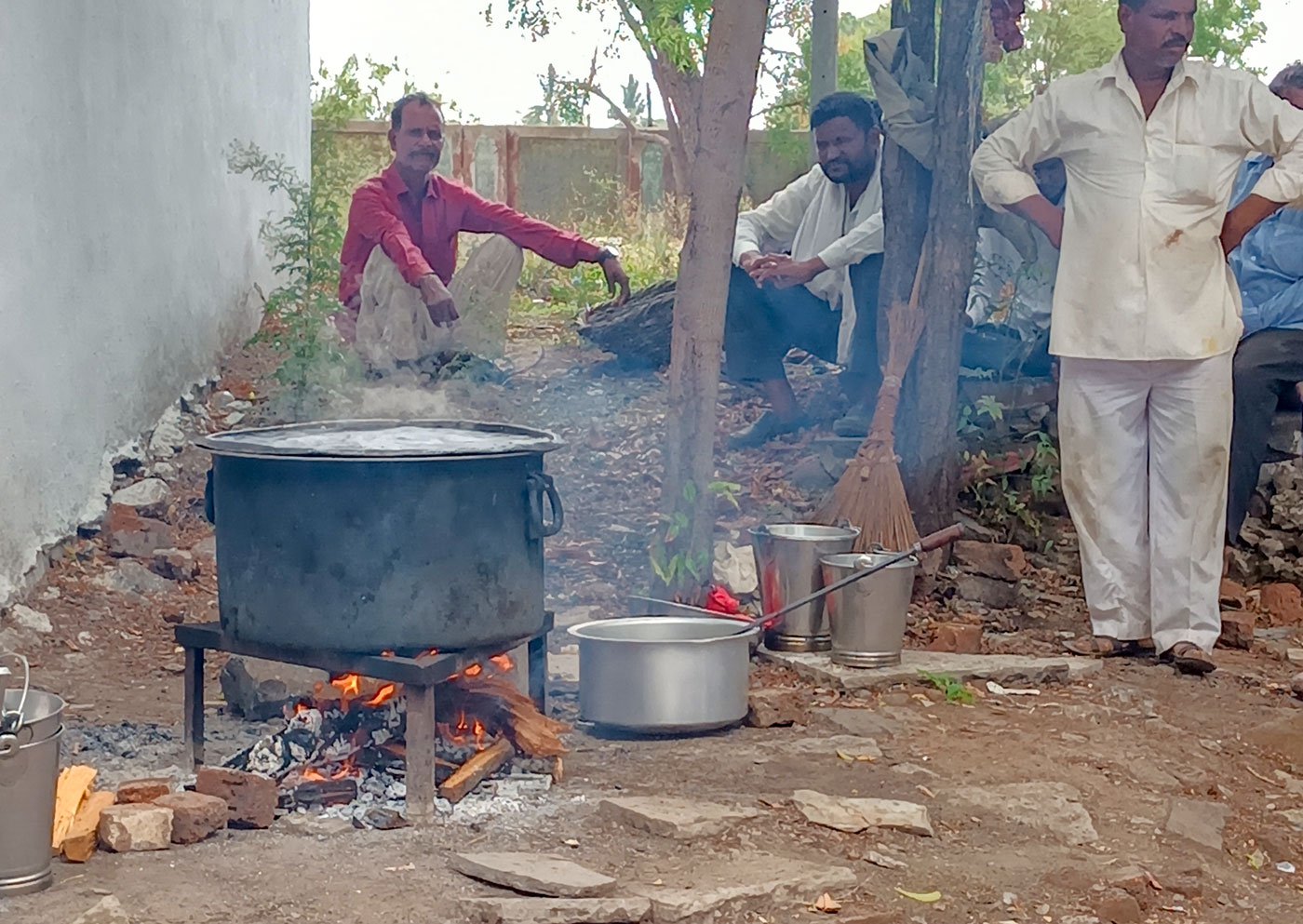
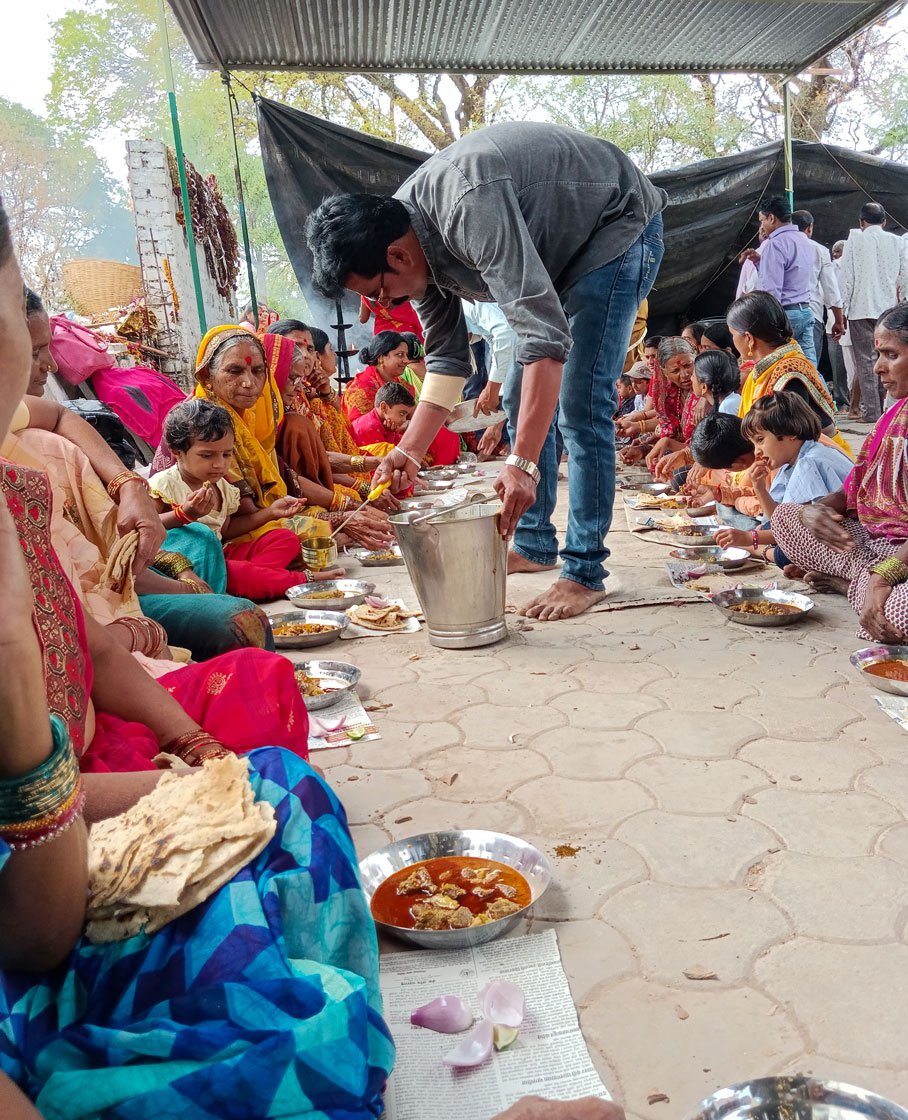
Left: Men are in charge of both cooking and serving the meat. Right: Men serve the mutton dish; women eat after making hundreds of bhakri
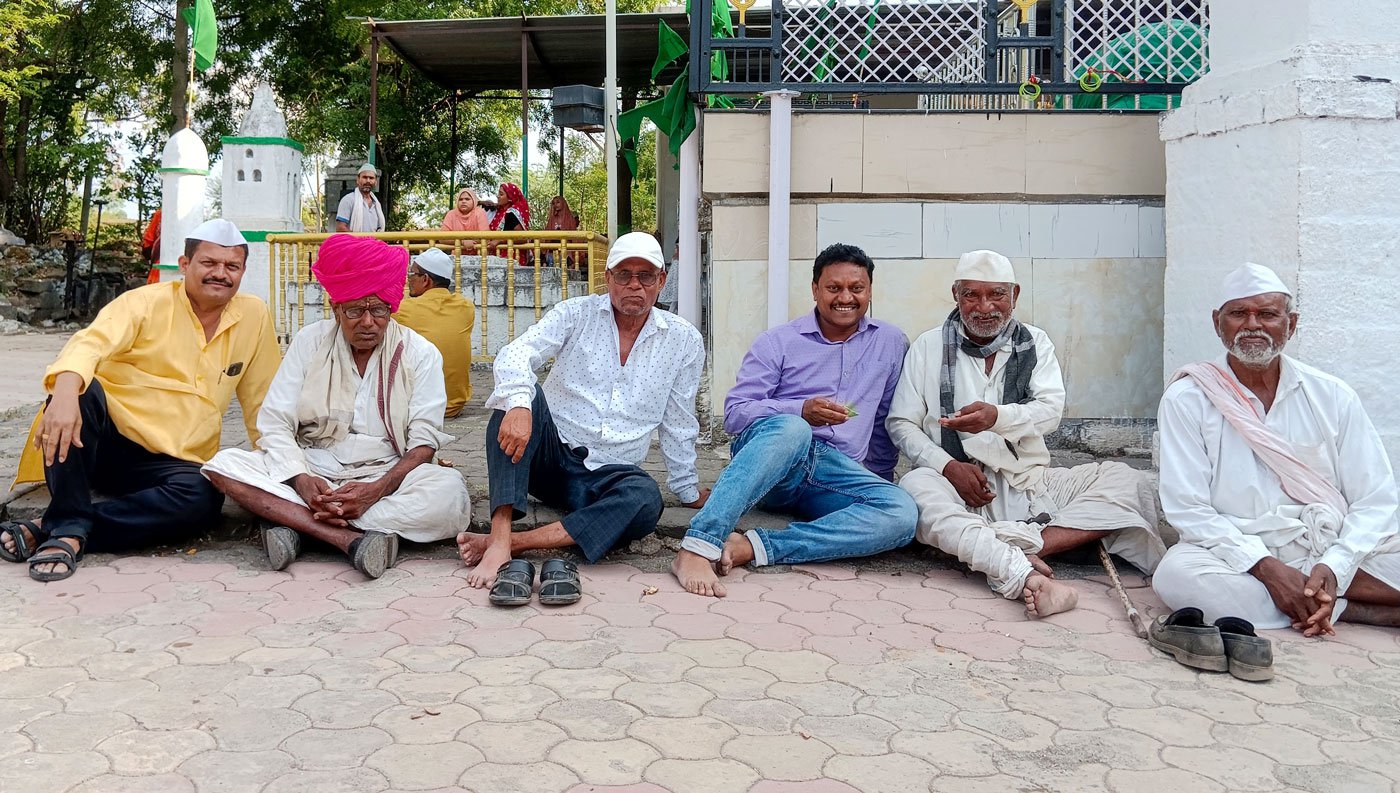
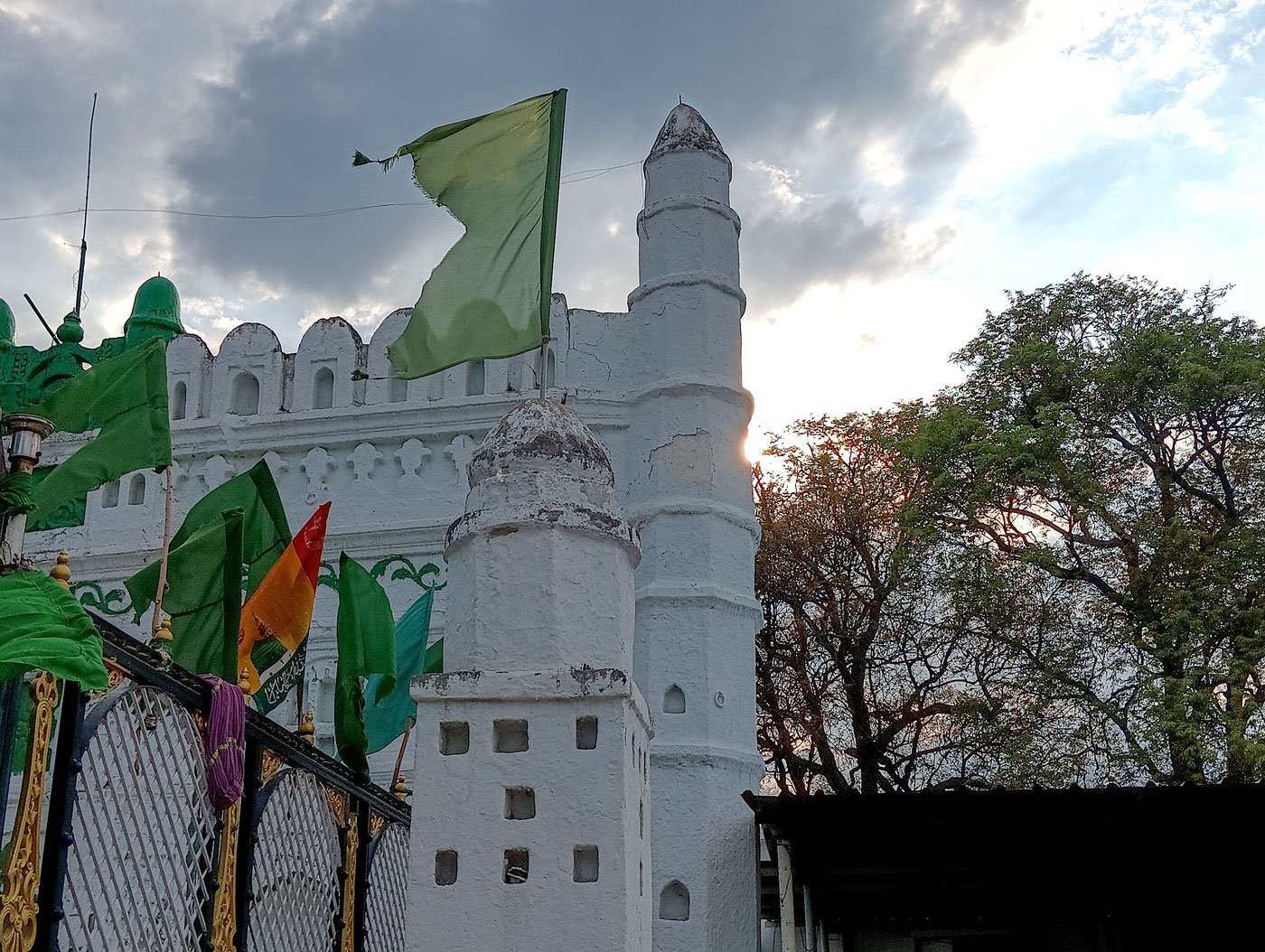
Left: Men sitting and chatting after the feast, sharing a paan and some laughs. Right: The region of Marathwada was under Islamic rule for more than 600 years. Belief and worship at these Islamic shrines are ingrained in people’s faith and rituals – representing a syncretic way of life
The cooking of the meat is a task done exclusively by men during these feasts.
Mouth-watering and aromatic biryani is being served by the Muslim devotees. Five bhakri s, a pot full of gravy and select portions of meat and a sweet malida, made of crushed wheat chapatis, ghee and sugar or jaggery, is offered as nivad to the mujawar at the dargah . The men go near the mazar and offer the nivad (offerings). Women sit outside near the steps, watching and seeking blessings, their heads covered with the end of their sarees as though in a temple.
Once the prayers are over and gifts exchanged, the feast begins. Women and men eat in separate rows. Those on fast eat upvaas food. The feast is formally over only when food has been served to five fakirs (mendicants) and five women working in the dargah .*****
A few weeks later, my 75-year-old mother-in-law, Gayabai Kale has organised a feast at a dargah close to home. She has been planning one for a while now and this year (2023), she is joined by her younger daughter, Zumbar in Shera, a small village in Renapur block of Latur, Maharashtra.
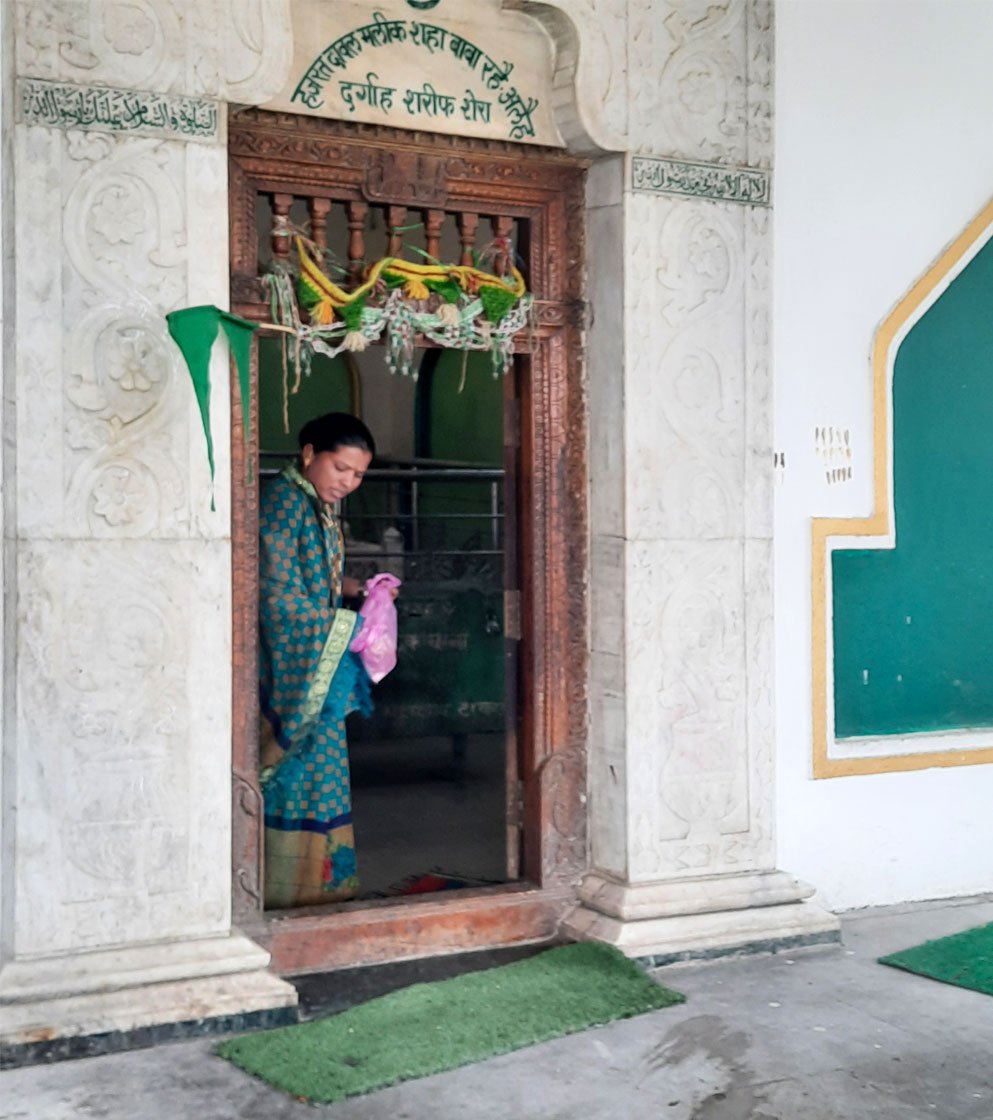
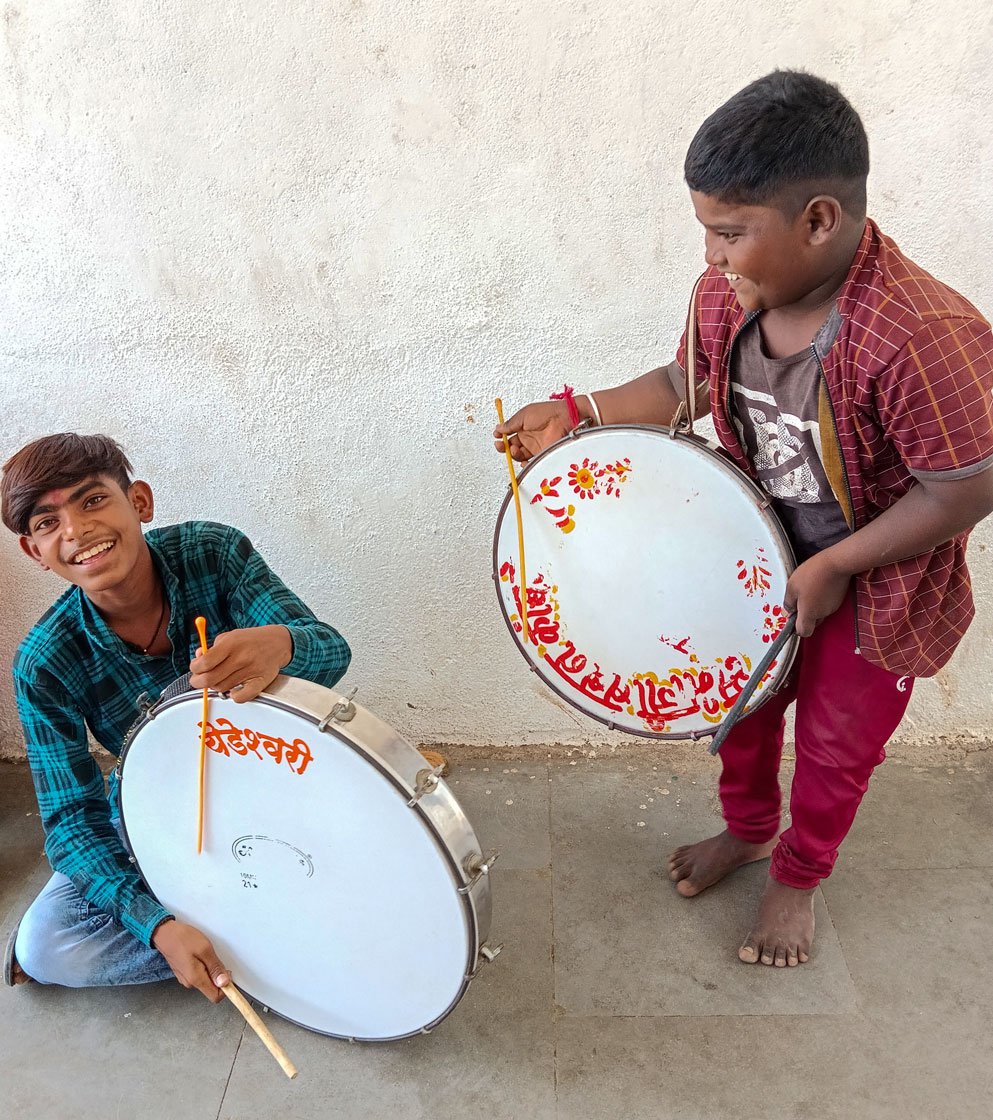
Left: A woman devotee at Dawal Malik dargah in Shera coming out after offering her prayers at the mazar . Right: Shriram Kamble (sitting on the floor) and his friend who did not want to share his name enjoying their time out
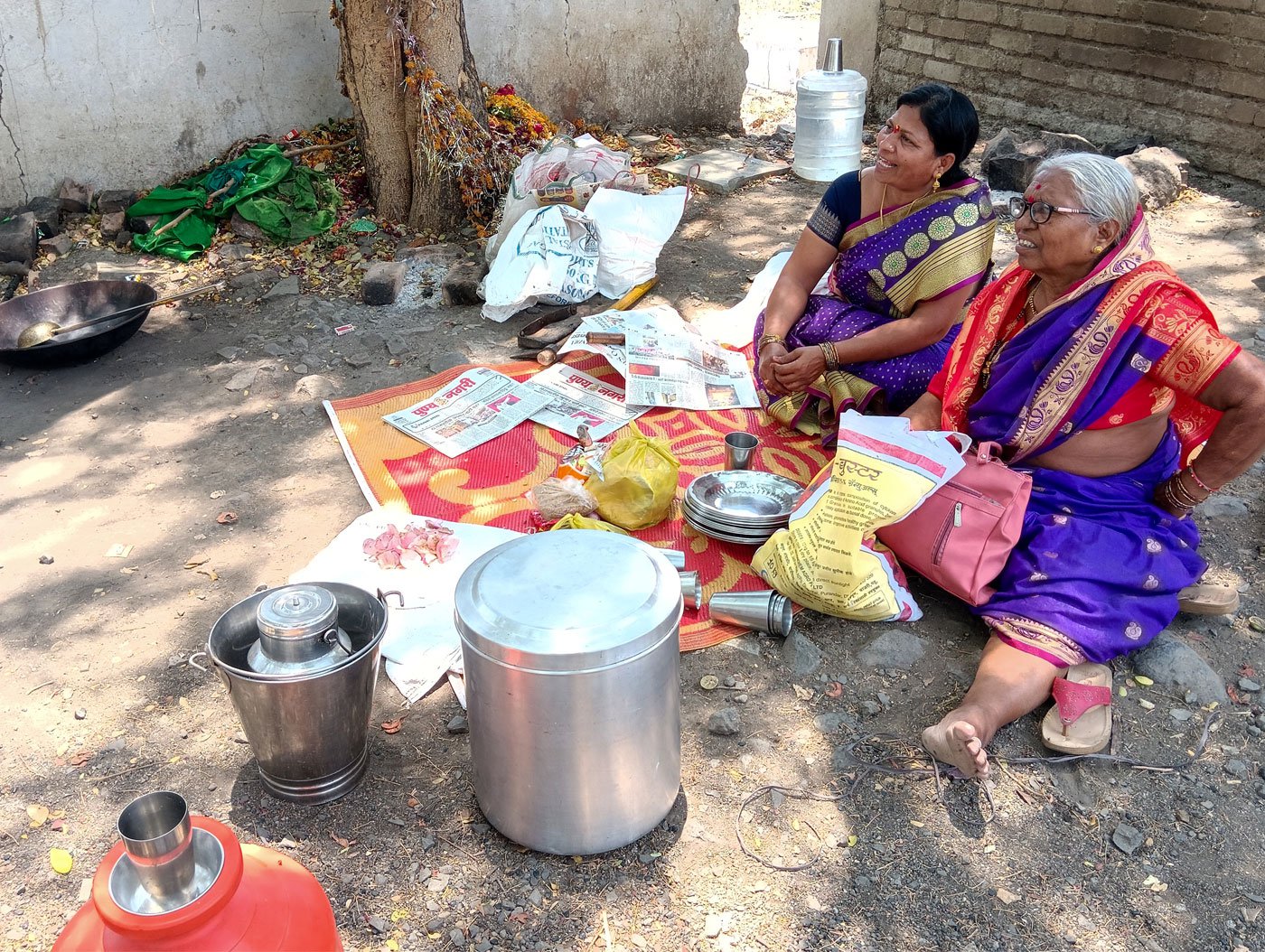
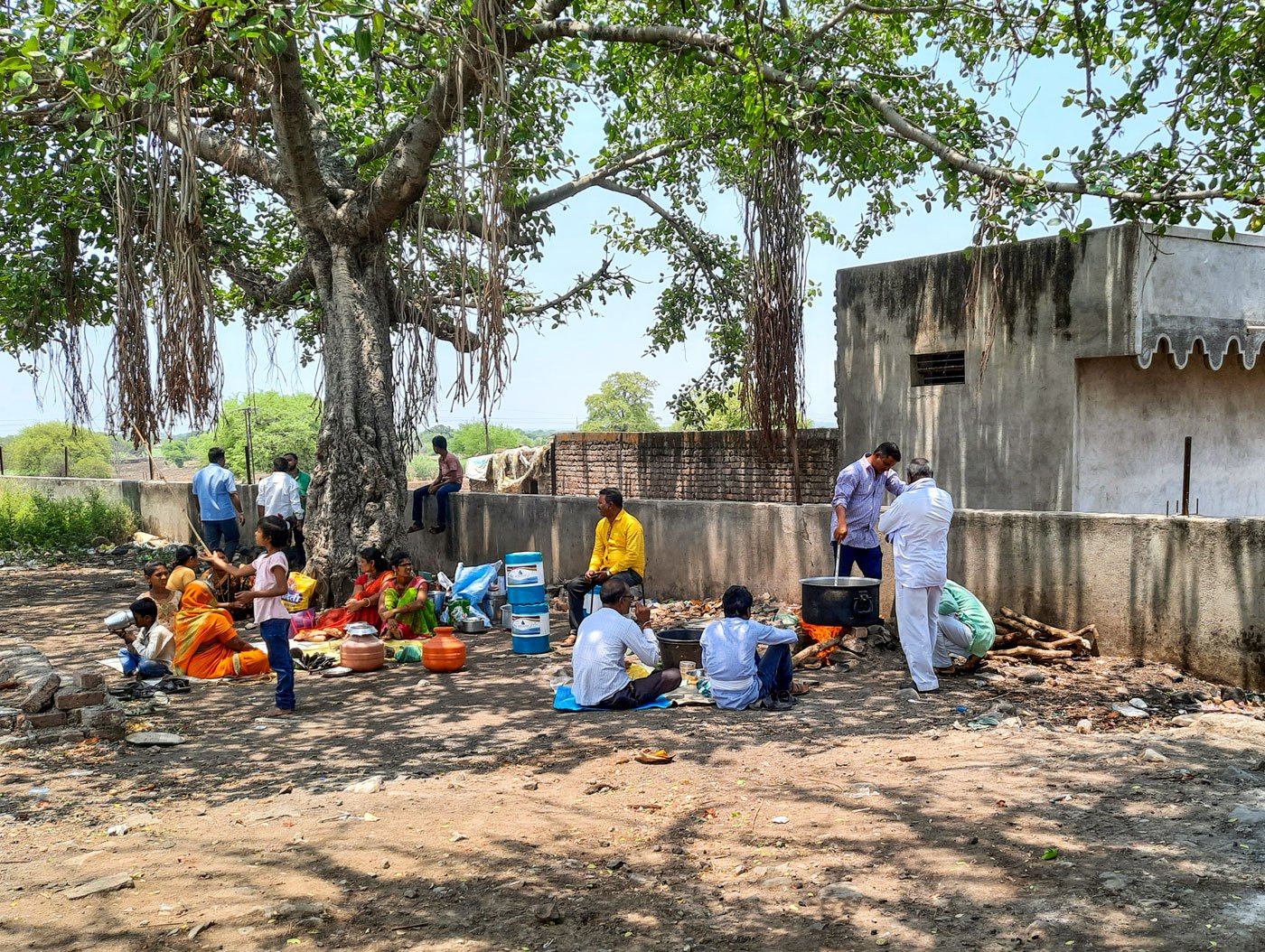
Left: Gayabai Kale is joined by her daughter Zumbar in the annual kanduri at Dawal Malik in Latur district. Right: A banyan tree provides some shade and respite to the families who are cooking the meat, as well as families waiting to offer nivad and prayers at the dargah
This dargah, Dawal Malik, is smaller than the one at Moha. We meet 15 Hindu families belonging to different castes. A group of women sit in front of the mazar and sing a few bhajans, devotional songs revering Hindu gods; some are speaking to an elderly Muslim fakir , seeking advice on domestic matters. A band of boys, mostly Dalit and who are still not welcome in many temples, play halgi (drum) when people offer nivad .
Gayabai’s elder son Balasaheb Kale oversees the cooking. A small farmer from Borgaon Bk in Latur, he helps her with having the goats slaughtered. He also makes a spicy, delicious curry. The mother-daughter duo offers nivad and the family eats while sharing food with others present at the dargah .
For the women I meet in the two dargahs , this ritual of offering prayers and a feast is like a promise that must be kept. “This is not a choice. Vajha asata, utarava lagata [It is a burden, one needs to offload].” They fear something terrible will happen if that promise is not kept.
Through the visit, the cooking, the feasting, and the sharing, they retain their Hindu identity, and see these shrines as also their own revered places of worship.
“This [peer] is my deity, and I will keep worshipping it. My grandfather did it, my father did it and I will continue to do it,” Gayabai says, with conviction and unwavering faith.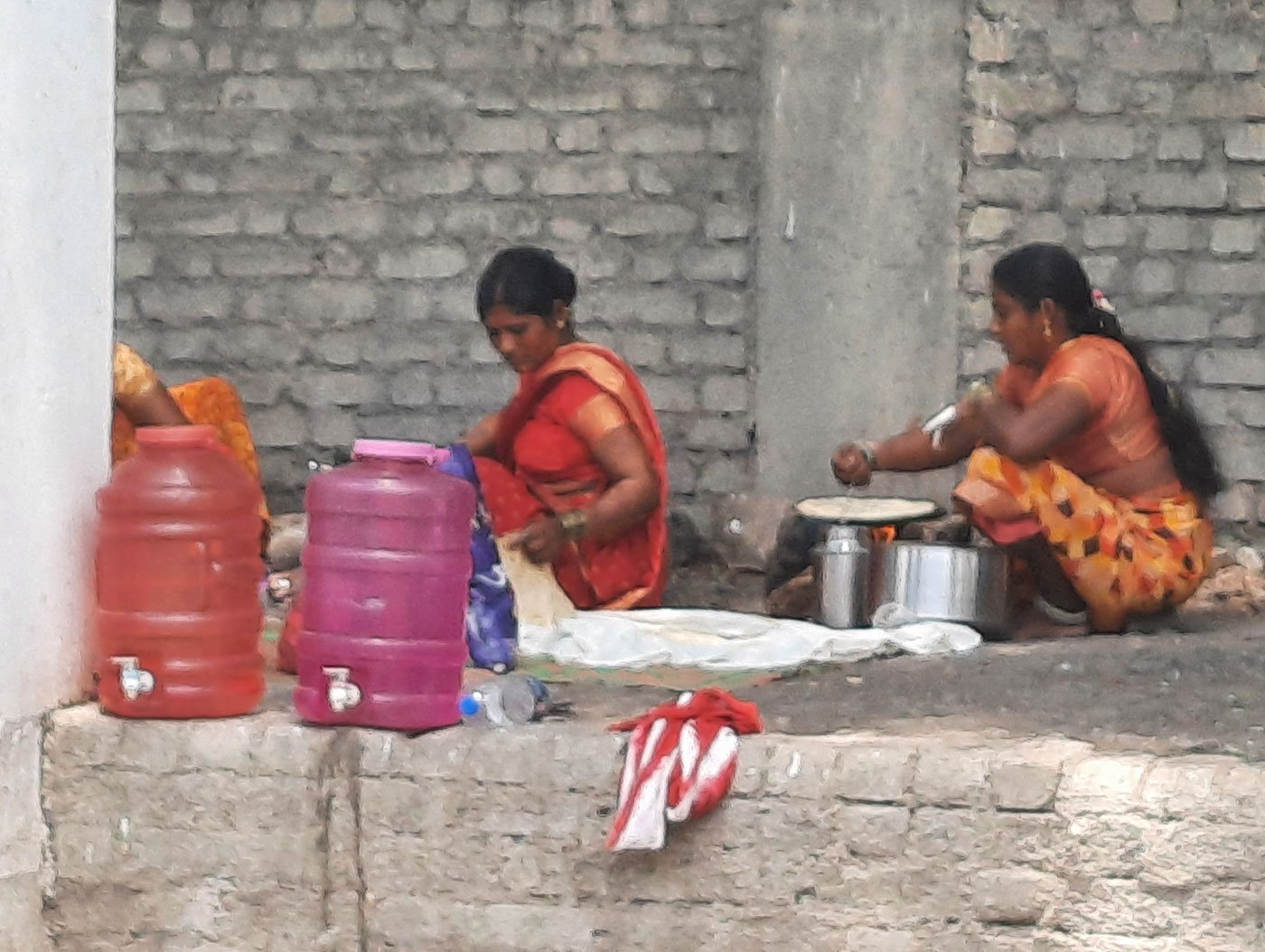
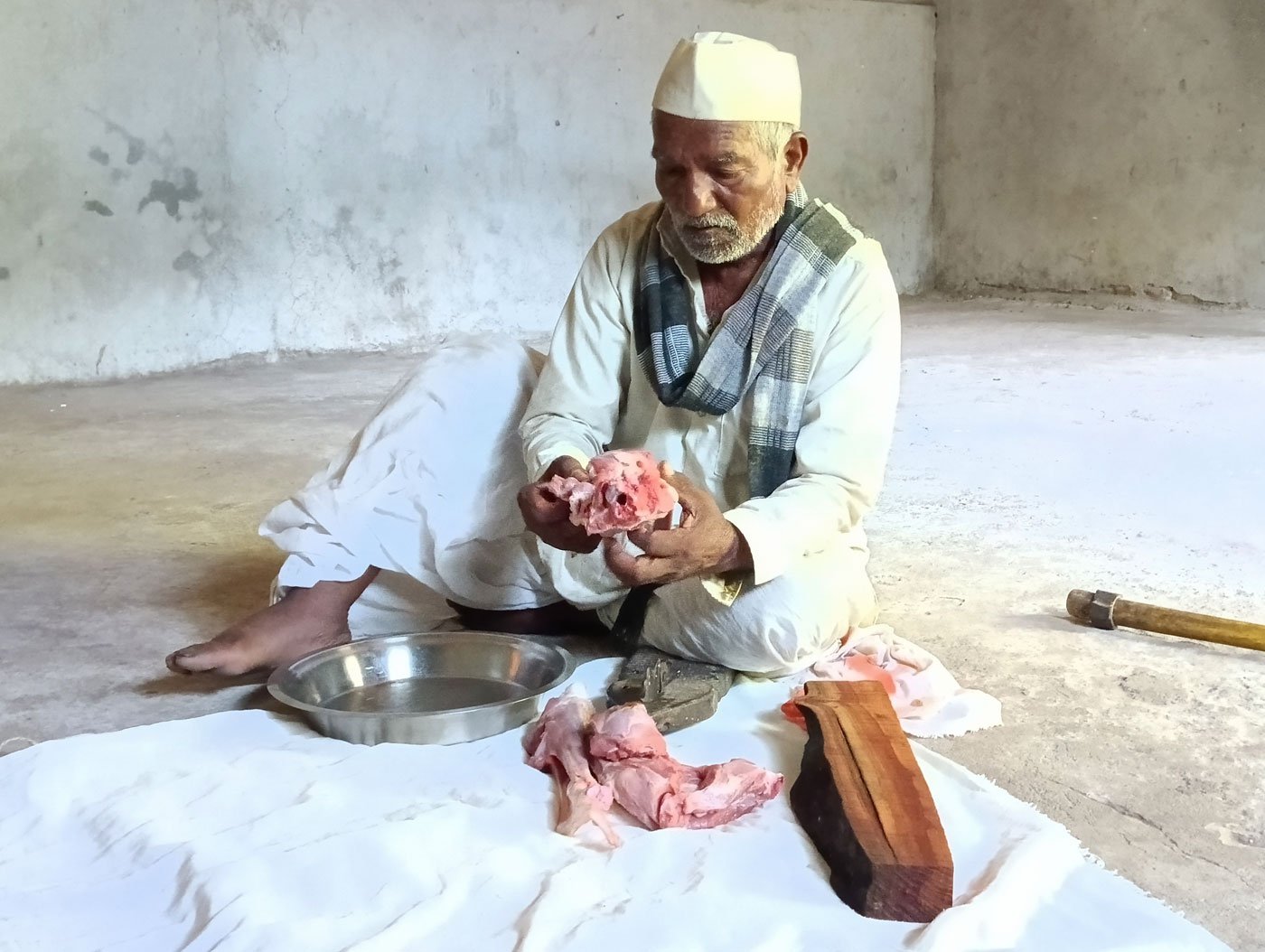
Left: Women spend hours making hundreds of bhakris for the kanduri feast. Right: Men like Maruti Fere, Gayabai’s brother, preparing the mutton
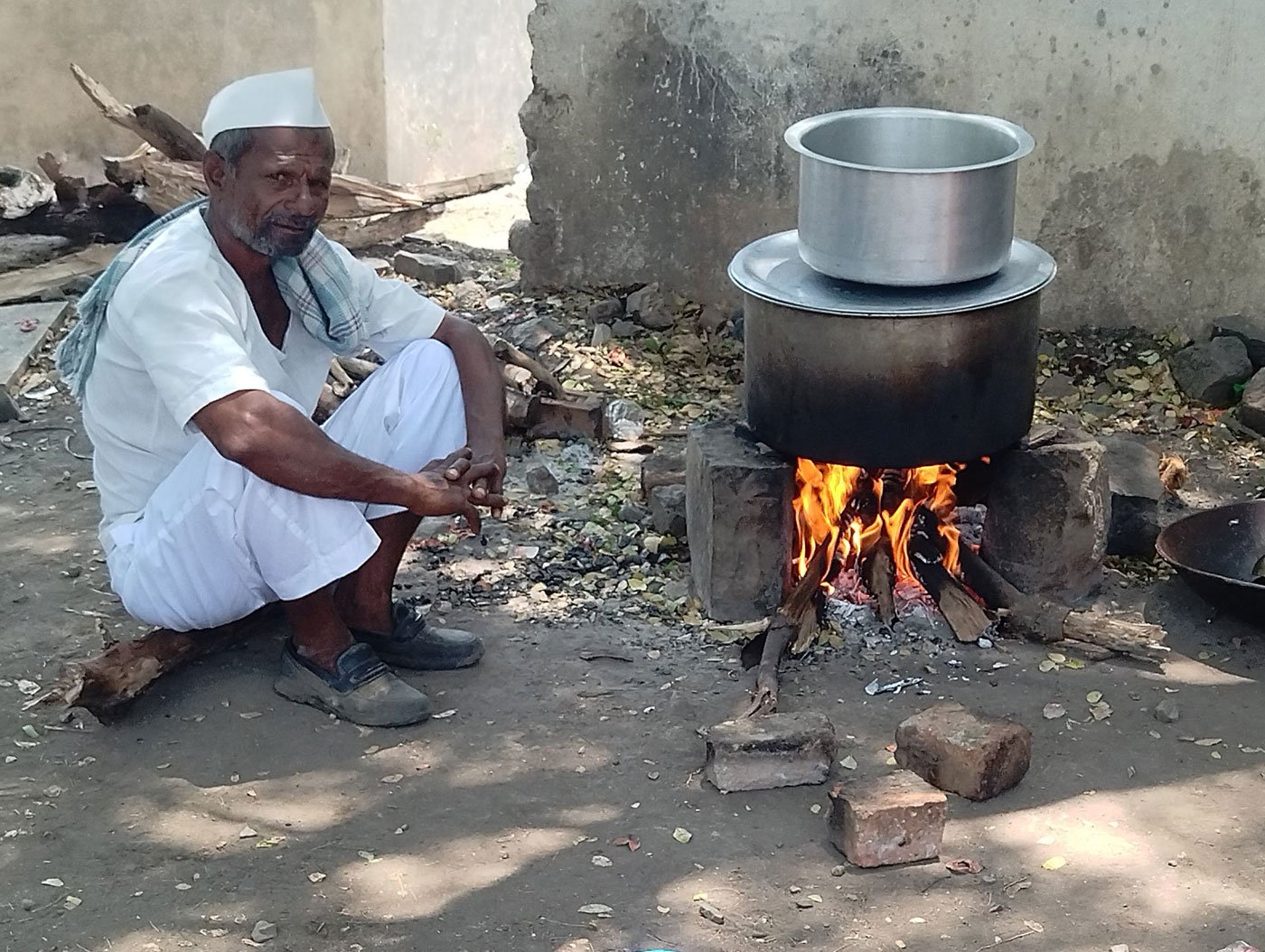
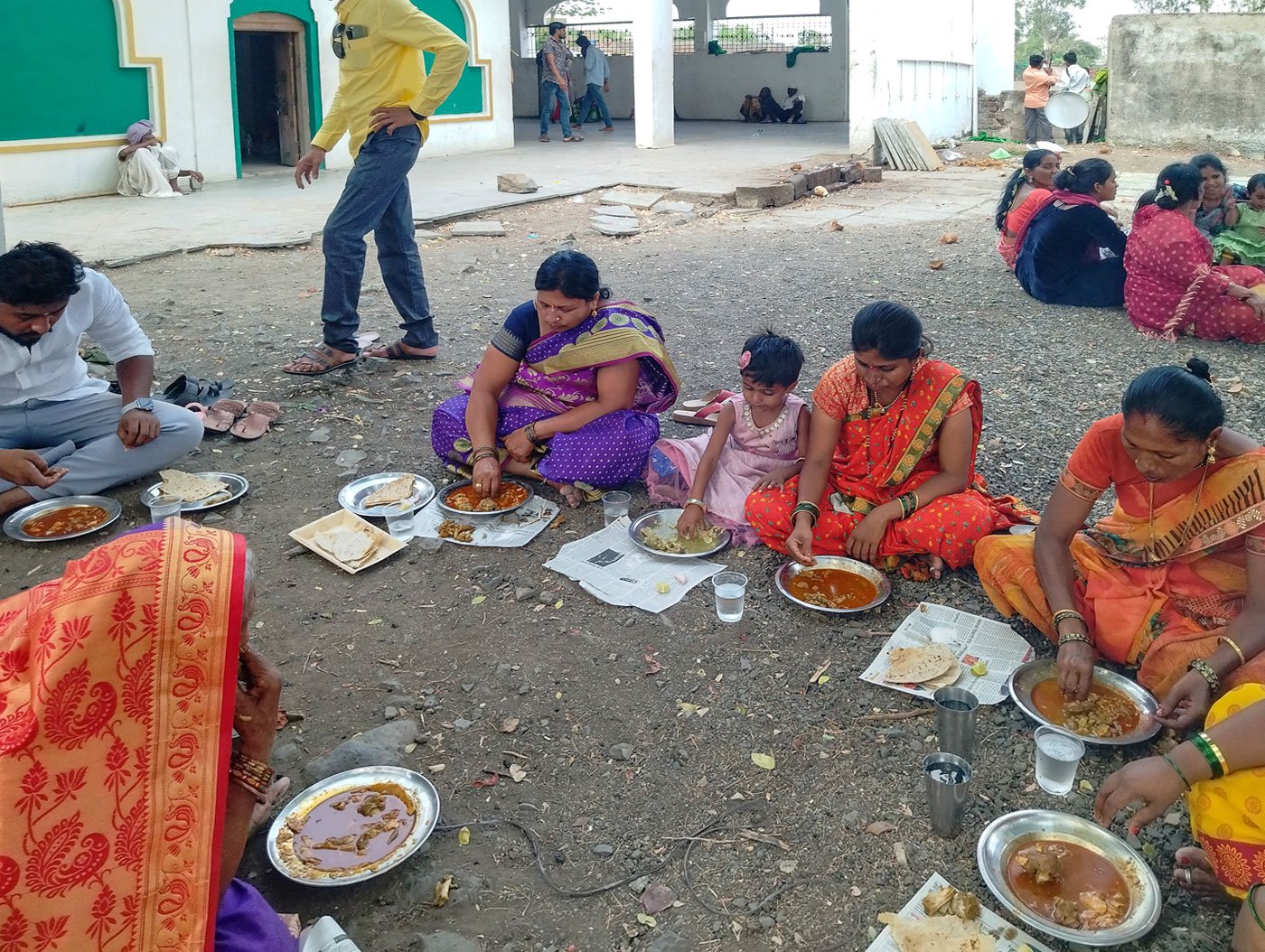
Left: Balasaheb Kale is in charge of cooking the meat at dargah Dawal Malik. Right: Prayers and nivad are offered at the mazar and Kale family eats the kanduri meal
*****
The very month (May 2023) that Gayabai, Bhaga mavshi and others were sealing their promises and visiting dargahs , 500 kilometres away, Salim Sayyad a resident of Trimbakeshwar went to offer sandal-dhoop at the entrance of the Tryambakeshwar temple in Nashik district. In his sixties, he was joined by others who went along with him, following a practice of more than 100 years.
They had unwavering faith in their own ‘Tryambak Raja’ and hence the annual urs to offer a chadar .
But Sayyad and the others were rudely stopped at the entrance and accused of forceful entry into the temple. A fanatic Hindu leader told the Muslim men to ‘restrict their worship to their own shrines’. They were further charged with hurting the religious sentiments of Hindus who worshipped there. A special investigation team (SIT) was formed to look into the ‘act of terrorism’.
A shocked Sayyad tendered a public apology. He promised to stop this centuries-old practice to maintain social harmony, an irony that went unremarked.